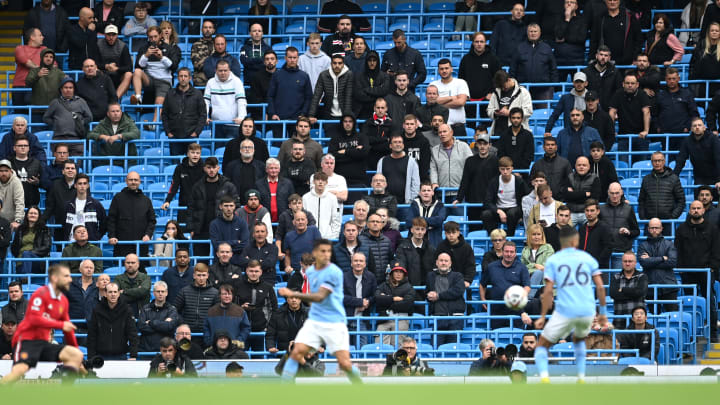What is safe standing? Rules explained & all approved Premier League stadiums

The eagle-eyed folk among us may have noticed a bunch of relentless standers at particular Premier League stadia this season.
Football lovers in the United Kingdom have gotten used to sitting while enjoying their favourite team in action live in the flesh thanks to changes in legislation at the turn of the 90s.
Pretty much ever since all-seater stadiums were introduced, however, clubs and supporters have pleaded for standing areas to make a comeback. The context in which they were banned, though, rendered a reversal unlikely.
In 2023, however, safe standing has made a return to major football stadia following government intervention.
What is safe standing?
Safe standing, in essence, is allowing a designated number of fans to stand while watching a sporting event inside a stadium.
Under licensed standing, fans can stand for matches in allocated zones behind a barrier or a rail. Each supporter has to occupy the same area they would take if they were sitting, with a traceable, numbered ticket.
Supporters will also have the option to sit, but so many enjoy standing while watching their team play.
Safe standing is common across Europe, especially in Germany, but it has only recently returned to England and the Premier League.
Why was safe standing banned in the United Kingdom?
Legislation was passed in the wake of the 1989 Hillsborough disaster in which 96 Liverpool fans were unlawfully crushed and killed as a result of police negligence.
Safe standing areas were to be removed from stadia so that a disaster akin to Hillsborough would be avoided. Quickly, every stadium in England's top two divisions became all-seaters.
When was safe standing brought back?
The UK government announced in July 2022 Premier League and Championship clubs were allowed to reintroduce safe standing areas for the 2022/23 season.
Then sports minister Nigel Huddleston said: "Based upon what I have experienced and we have learnt through the pilot programme, safe standing is set to deliver an electric atmosphere at our football stadiums.
"Fans have long campaigned for its introduction and we have worked carefully with supporters groups, including the families affected by the tragic Hillsborough football disaster.
"I am proud of the work that has gone into this rigorous process and that we have delivered on our manifesto commitment to get fans back on their feet in stadiums."
Cardiff City, Chelsea, Man City, Man Utd and Tottenham all took part in test events during the second half of the 2021/22 season to see whether the return of safe standing was viable.
After crunching the numbers from the tests, safe standing was then deemed safe to make a full return.
Why has safe standing been reintroduced?
After test events began at the start of 2022, the Sports Grounds Safety Authority published a report in April which provided multiple reasons why safe standing areas should make a return.
These reasons include more orderly goal celebrations, barriers providing stability for people moving through aisles, easier access to seats for latecomers, and pockets of overcrowding being easier to identify.
The final report from the trial added the exit of fans from stadia would be more uniform in safe standing areas, and that there was no evidence these areas encouraged more fans in seated areas of the stadium to remain standing.
Where has safe standing been approved in the Premier League?
Chelsea, Tottenham, and the two Manchester clubs took part in testing, while Brentford and Aston Villa also added safe standing areas at the start of the 2022/23 season.
Safe standing was also installed at Wembley Stadium ahead of the 2023 Carabao Cup final with a total of 2,000 spaces available. However, these can only be used for domestic fixtures.